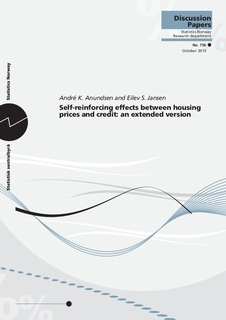Self-reinforcing effects between housing prices and credit: an extended version
Working paper
Published version

View/
Date
2013-10Metadata
Show full item recordCollections
- Discussion Papers [1003]
Abstract
The financial crisis has brought the interaction between housing prices and household borrowing into the limelight of economic policy debate. This paper examines the nexus of housing prices and credit in Norway within a structural vector equilibrium correcting model (SVECM) over the period 1986q2- 2008q4. The results establish a two-way interaction in the long-run, so that higher housing prices lead to a credit expansion, which in turn puts an upward pressure on housing prices. Interest rates influence housing prices indirectly through the credit channel. Furthermore, households’ expectations about future development in teir own income as well as in the Norwegian economy have a significant impact on housing price growth. Dynamic simulations show how shocks are propagated and amplified. When we augment the model to include the supply side, these effects are dampened. The paper is an extended version of Anundsen and Jansen (2013b) and it encompasses a previous Discussion Paper 651 (Anundsen and Jansen, 2011).
Publisher
Statistisk sentralbyråSeries
Discussion papers;756Related items
Showing items related by title, author, creator and subject.
-
The impacts of alternative policy instruments on environmental performance. A firm level study of temporary and persistent effects
Bye, Brita; Klemetsen, Marit Elisabeth (Discussion papers;788, Working paper, 2014-10)We study the effects of various environmental regulations on environmental performance measured as emission intensity. Moreover, we aim to test whether any such effects are persistent or only temporary. Conventional theory ... -
The welfare effects of carbon policies: grandfathered quotas versus differentiated taxes
Bye, Brita; Nyborg, Karine (Discussion Papers;No. 261, Working paper, 1999)Recently, it has been demonstrated that pre-existing distortionary taxes can substantially increase the costs of market-based instruments which do not raise revenue, such as non-auctioned emissions quotas. Revenue-raising ... -
Labour market rigidities and environmental tax reforms : welfare effects of different regimes
Bye, Brita (Discussion Papers;No. 242, Working paper, 1998)The working of the labour market is important for the total welfare effects of tax reforms. This paper analyses, by using a computable general equilibrium model for the Norwegian economy, how different assumptions about ...